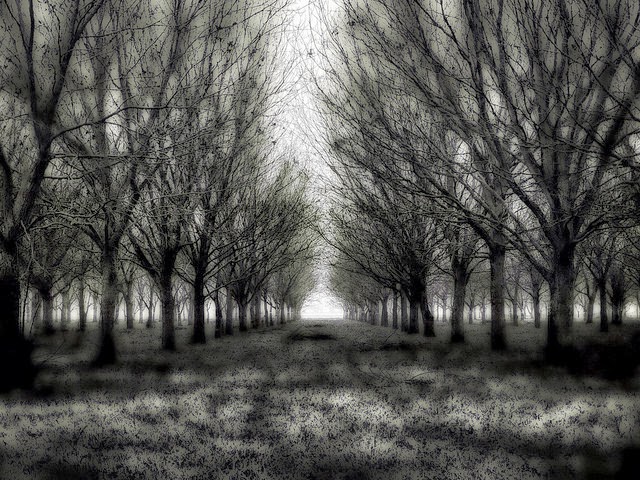Today I continue talking about murderously good mysteries and how to write them.
The Five Elements: Milieu, Victim, Murderer, Suspects, Detectives
In "The Guilty Vicarage: Notes on the detective story, by an addict," W.H. (Wystan Hugh) Auden writes:
"The detective story has five elements — the milieu, the victim, the murderer, the suspects, the detectives."
I want to look at each of these in turn but that's going to take a while so, for today, let's start with a murder mystery's milieu.
Milieu
a. The Society/Setting must be closed.
I think that what W.H. Auden meant by "society" was, in practical terms, the sum total of characters that would have to be taken into consideration when solving the murder. One's pool of suspects.
Small suspect pool. When Auden writes that the society must be closed he means that, in selecting the setting, we need to pick something that will limit the number of people who could have committed the murder; that is, limit the number of suspects we'll have to deal with.
For example, in Agatha Christie's Murder at the Vicarage the society would be everyone in the village of St. Mary Mead where the murder took place. The suspects are those who had, or could have had, the means, motive and opportunity to kill the victim, Colonel Lucius Protheroe.
One murderer. In addition to having a relatively small suspect pool it must also be clear that the murderer is one of the people in the society you set up. Auden writes that what the murder mystery writer needs to avoid is any possibility the murderer comes from outside the society. For example, it wouldn't do for the murderer to be someone on a road trip from London who killed the Colonel for kicks and then drove back to London.
It must be clear from the beginning that one of the people in the society (in the case of my example, the village of St. Mary Mead) must have committed the crime. The only question is: who?
By the way, it doesn't have to be just one murderer, but the principle of parsimony applies and if the evidence doesn't suggest more than one murderer was at work, it's likely best not to complicate matters. On the other hand, as time goes on it may appear that there was more than one murderer. In several of Agatha Christie's books it turned out this was the case but she tended to use this as a twist near, or at, the end of the tale.
Every character within the society should have multiple connections with every other member.
Characters, like people, aren't islands unto themselves; each character has--or should have--multiple connections to every other character. This raises certain questions: i) what kind of connections and ii) how are they relevant to the murder (many connections probably wouldn't be) and iii) how will the sleuth discover them?
Kind of connections. Auden writes that everyone in the society should be closely related either by family ties, by geography (a small village such as St. Mary Mead), by occupation (they all work at the same company or go to the same lodge) or by happenstance (happen to be trapped in an aeroplane together).
Relevance and discoverability. Each and every character should be a potential suspect, but the detective might have to dig a bit; do some research, interview a few characters; to figure out the exact nature of the connection between the suspect and the victim and whether it's relevant to the murder.
In the beginning, the members of the group--the society--will first appear to be strangers to each other, but the sleuth will discover they have many interesting, intimate (and possibly scandalous) connections with each other.
Examples:
- Group of relatives (Auden gives the examples of the Christmas dinner at the country house).
- Geography keeping people together; a small rural village, a college campus, a military academy.
- A group of people who work together. Auden suggests a theatre company, but it could also be a band, choir, writers' convention, and so on.
- A group isolated by technology: an airplane, a train, an RV, and so on.
b. Nothing bad ever happens here.
Auden writes that:
"Nature should reflect its human inhabitants, i.e., it should be the Great Good Place; for the more Eden-like it is, the greater the contradiction of murder. The country is preferable to the town, a well-to-do neighborhood (but not too well-to-do-or there will be a suspicion of ill-gotten gains) better than a slum. The corpse must shock not only because it is a corpse but also because, even for a corpse, it is shockingly out of place, as when a dog makes a mess on a drawing room carpet." (Auden)
The setting should be unsullied by murder. The society should be such that murder is ... well, if not unthinkable, then very very unlikely. A nunnery, academia, the church choir. This way, when murder occurs, the crises is greater. If a murder were to occur, say, in the bad area of a big city late at night we wouldn't be as shocked than if it occurred in the middle of a play on a cruise ship in mid-afternoon.
Also, having the murder occur in a setting, a context, where murder is rare helps put pressure on the law to solve the crime in order that things can get back to normal.
In addition, the law itself would be a disruptive influence, one that many would find unwelcome. This may be bad for the characters, but it's great for the storyteller because it's a source of conflict. Every character--even the (apparently) most blameless, most upright, is cast under the same pall of suspicion. This makes everyone--everyone except the murderer!--anxious to expose the murderer and get things back to the way they were.
Characters
Auden writes:
"The characters in a detective story should [...] be eccentric (aesthetically interesting individuals) and good (instinctively ethical) — good, that is, either in appearance, later shown to be false, or in reality, first concealed by an appearance of bad."
In other words, it should, on the face of it, seem implausible that any of the suspects committed the murder. (If there is someone around who hated the victim then give them an ironclad alibi.)
As the murder mystery unfolds, those who seemed to have no motive will become serious contenders for the murder. Similarly, those who seemed most likely to commit the murder will be shown either not to have had the opportunity, or to have vastly different motives than it first appeared.
Thats it for today! It looks as though these posts have morphed into a series. In the next instalment I will look at what W.H. Auden--lifelong lover of murder mysteries that he was--had to say about what makes the perfect victim. In the meantime, good writing!
Photo credit: "Recreation" by *Light Painting* under Creative Commons Attribution 2.0.


